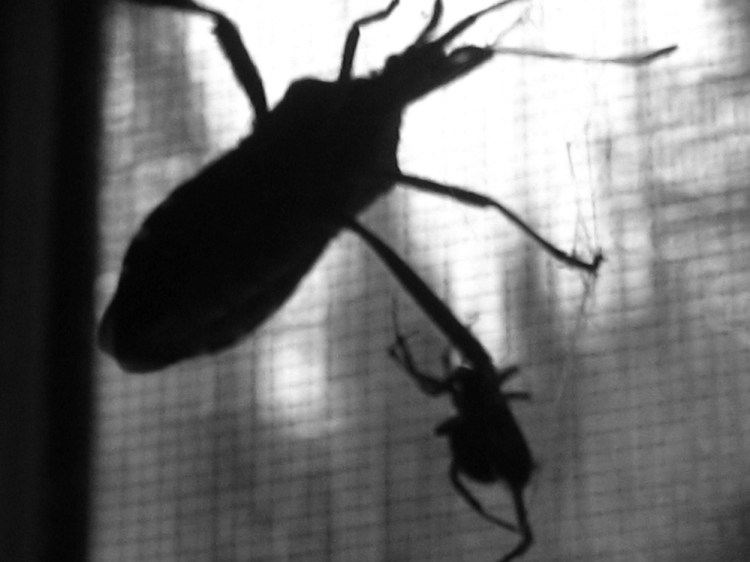A few days before Halloween, I was innocently washing up a few dishes at the sink and looking out the window at rain and the October blitz of juncos hopping around in the leaves. Cute, cheerful, industrious little fellows with slate-gray backs.
A flicker of movement drew my eye to the upper left corner of the window. Struggling there upside down in a cobweb was a Western conifer seed bug. These guys invade the house every October and November to get out of the cold. They started showing up here 10 or 12 years ago, apparently as climate-change emigrants from out west. They fly around like disabled Cessnas crashing into things and people’s heads, and when they get scared, they nip. Not bad, but enough so you feel it. I usually put them outside.
This bug was in for something more horrible than October cold and rain, though. The owner of the cobweb, a house spider (family Theridiidae), scooted down the web and started working silk near the bug’s legs. The bug was four or five times as big as the spider. When the house spider approached, the conifer seed bug struggled and tried to fend off the spider with its second, longer leg. The spider quickly lashed silk near the bug’s foot and then ran back along the cobweb.
In a few seconds it returned, dodging the bug’s kicking leg, made a few more lashings with deft movements of its front and second sets of legs, then dashed back. It ran back up the web, apparently tying off strands of silk paid out for the leg-tying. Sometimes it tied off the strand in one spot, sometimes it made a semicircuit to several places where it worked for a few seconds, and then it ran back to the bug. The bug writhed futilely, kicking at the spider, but the spider would quick fasten a bit of silk around the end of the leg and scoot back up the web to tie it off.
This went on for quite a while. The spider tied the conifer seed bug’s legs down one strand of silk at a time, until first the longer kicking leg and then the smaller foreleg were both more or less shackled to the web.
At this point I left the scene for about two minutes to see what the cat had knocked over. When I returned, the conifer seed bug was no longer struggling, and there was a strong, moldy-pinelike stink in the kitchen, a smelly secretion the bug gives off in self-defense. The spider, no doubt, with the bug’s legs lashed fast to the web, had run up and sunk the fangs in its side-to-side jaws (or chelicerae) into the bug and injected it with paralyzing venom. The stink defense didn’t work.
The spider then retreated to the corner of the window. I assume it stayed there until the bug was completely paralyzed. Then it would start to eat.
The next day the conifer seed bug was hanging upside down farther up the web. Spiders of the Theridiidae family, such as the house spider and the widow spiders, do not tear apart their prey, as some other spiders do. Instead they make an incision in the bug’s body, into which they spew enzymes that digest tissue. The spider’s stomach then acts like a pump, sucking the digested material into the spider’s mouth and down its gut.
The spider ingests only soft material its body can absorb. Any hard particles that do not get pre-digested (especially among spiders that first tear their prey apart and then soften it up with secretions) are filtered by hair around the spider’s mouth and by platelets in the pharynx. Strange as it may sound, after a meal the spider washes up by cleaning the filtered debris from its mouth and hair.
The house spider probably got a number of meals out of the giant bug. Spiders by and large eat only living tissue. Or at any rate, things they kill themselves. The arachnologists don’t know how long the bug might have lived after receiving the paralyzing bite. I once watched a goldenrod crab spider muckle onto the face of a bee and hold it like that, sucking the insides out of its head for more than an hour, and thought that looked like a horrible way to die. This conifer seed bug, or at any rate its corpse, provided feasts to this house spider for three days, until one morning the hollowed-out body had been cut loose from the web and was lying on the window sash.
Even a few minutes of being eaten alive by a house spider must be like an eternal hell to a bug. And worse if it lived on helpless for an hour, or a day.
Anyway, the juncos were still about the yard after the spider finished with the bug, bopping around in the leaves and eating, thank goodness, mostly seeds.
Dana Wilde lives in Troy. His writings on Maine’s natural world are collected in “The Other End of the Driveway,” available from online booksellers or by contacting the author at naturalist@dwildepress.net. Backyard Naturalist appears the second and fourth Thursdays each month.
Send questions/comments to the editors.



